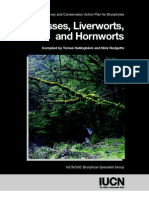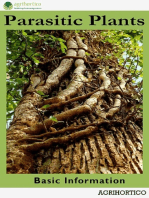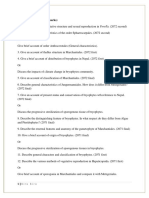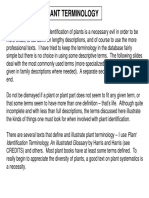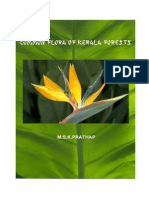Professional Documents
Culture Documents
Cryptogams and Phanerogams Are Two Sub
Uploaded by
sweet scorpioOriginal Description:
Copyright
Available Formats
Share this document
Did you find this document useful?
Is this content inappropriate?
Report this DocumentCopyright:
Available Formats
Cryptogams and Phanerogams Are Two Sub
Uploaded by
sweet scorpioCopyright:
Available Formats
Cryptogams and phanerogams are two sub-kingdoms of the kingdom Plantae.
This classification system
was introduced by A. W. Eichler in 1883. The main difference between cryptogams and phanerogams
is that Cryptogams consist of seedless plants whereas phanerogams consist of seed-bearing
plants. Cryptogams comprise plants like algae, mosses, and ferns. Cryptogams are non-flowering
plants, which mainly reproduce by the production of spores. They do not produce fruits. Phanerogams
comprise gymnosperms and angiosperms. Gymnosperms are non-flowering plants with naked-seeds
(seeds are not covered by a fruit). Angiosperms are flowering plants that produce seeds covered by a
fruit. Angiosperms are the most prominent vegetation on earth.
What are Cryptogams
Cryptogams refer to the seedless plants or plant-like organisms. Cryptogams form a sub-
kingdom in the kingdom Plantae called Cryptogamae. The major characteristic of the
Cryptogamae is that they reproduce by means of spores. Therefore, Cryptogams do not produce
flowers, seeds or fruits. They consist of hidden reproductive organs. And Many plant bodies of
Cryptogams are not differentiated into true leaves, stems, and roots. Many of them do not have
a vascular system as well. The sub-kingdom Crytogamae is further divided into three phyla;
phylum Thallophyta, phylum Bryophyta, and phylum Pteridophyta.
Thallophyta
Thallophyta consists of both unicellular and multicellular organisms. The multicellular body
can be either thallus-like or filamentous. Thallophyta comprises organisms that belong to three
kingdoms; kingdom Monera, kingdom Protista, and kingdom Fungi. The blue-green bacteria
of the kingdom Monera belong to Thallophyta. In the kingdom Protista, all red, green, and
brown algae belong to Thallophyta. Moreover, all fungi along with lichens belong to
Thallophyta.
Bryophyta
Bryophyta consists of liverworts, mosses, and hornworts. Most bryophytes grow in wet, shady
environments. They show alterations of generations along with a prominent gametophyte. The
plant body is not differentiated into true stem, root, and leaves. Bryophytes are non-vascular
plants.
Pteridophytes
Pteridophytes consist of ferns. Ferns are well-developed plants that grow in dry environments.
They also grow in wet environments. Ferns show the alterations of generations along with a
prominent sporophyte. Ferns are differentiated into true leaves, stem, and root. Ferns are
vascular plants.
What are Phanerogams
Phanerogams refer to the seed-bearing plants. The phanerogams are also called spermatophyte.
Phanerogams form a sub-kingdom in the kingdom Plantae called Phanerogamae. The major
characteristic of phanerogams is that they produce seeds. Phanerogams are vascular plants with
differentiated boy structures into leaves, stem, and root. The sub-kingdom Phanerogamae is
further divided into gymnosperms and angiosperms.
Gymnosperms
Gymnosperms are non-flowering plants that produce naked-seeds. Gymnosperms are
monocots since they develop from a single seed-leaf. They are vascular plants with an
unbranched, parallel vein system in the leaves. Gymnosperms can be divided into four phyla;
phylum Cycadophyta, phylum Ginkophyta, phylum Coniferophyta, and phylum Gnetophyta.
Angiosperms
Angiosperms are flowering plants that produce a seed covered by a fruit. They can be
either monocots or dicots. Angiosperms consist of a highly differentiated vascular system and
they are the most prominent group of plants on earth. Their reproductive structure is the flower.
They also show double fertilization. A passion flower and its fruit is shown in figure 5.
Difference Between Cryptogams and Phanerogams
Definition
Cryptogams: Cryptogams refer to a plant or plant-like organisms that produce spores.
Phanerogams: Phanerogams refer to the higher plants that produce seeds.
Classification
Cryptogams: Cryptogams consist of Thallophyta, Bryophyta, and Pteridophyta.
Phanerogams: Phanerogams consist of gymnosperms and angiosperms.
Major Reproduction method
Cryptogams: The major reproduction method of cryptogams is the production of spores.
Phanerogams: The major reproduction method of phanerogams is the production of gametes.
Plant Body
Cryptogams: Most cryptogams lack well-differentiated stem, leaves, and roots.
Phanerogams: The plant body of phanerogams is well-differentiated into stem, leaves and
roots.
Vascular System
Cryptogams: Cryptogams do not have a well-developed vascular system.
Phanerogams: Phanerogams have a well-developed vascular system.
Reproductive Organs
Cryptogams: Cryptogams contain hidden reproductive organs.
Phanerogams: Phanerogams contain well-developed reproductive organs.
External Water for Fertilization
Cryptogams: Cryptogams require external water for fertilization.
Phanerogams: Phanerogams do not require external water for fertilization.
Seeds
Cryptogams: Cryptogams are seedless plants.
Phanerogams: Phanerogams are seed-bearing plants.
New Plants
Cryptogams: Spores germinate and produce new plants in cryptogams.
Phanerogams: Seeds germinate and produce new phanerogams.
Evolution
Cryptogams: Cryptogams are less evolved plants.
Phanerogams: Phanerogams are well-evolved plants compared to cryptogams.
Examples
Cryptogams: Algae, mosses, liverworts, hornworts, and ferns are the examples of cryptogams.
Phanerogams: Conifers, Ginko, cycads, gnetophytes, and dicots are the examples of
phanerogams.
Conclusion
Cryptogams and phanerogams are two sub-kingdoms of the kingdom Plantae. Cryptogams
consist of seedless plants and plant-like organisms whereas phanerogams consist of seed-
bearing plants. Cryptogams do not develop flowers and fruits as well. Most Cryptogams do not
have a vascular system. Cryptogams can be divided into Thallophyta, Bryophyta, and
Pteridophyta. In contrast to Cryptogams, phanerogams are highly developed plants with a
vascular system and plant body differentiation. The two classes of phanerogams are
gymnosperms and angiosperms. Gymnosperms are non-flowering plants with a naked-seed.
Angiosperms are flowering plants with seeds covered by fruits. The main difference between
cryptogams and phanerogams is the presence or absence of seeds.
Distinguishing Characteristics of Plant Families
1. Brassicaceae (Cruciferae) Mustard Family
a. Leaves are often deeply lobed and pinnatifid.
b. Flowers are actinomorphic and without subtending bracts (ebracteate).
c. Perianth is of 4 sepals and 4 petals in a cruciform (cross-like) arrangement.
d. Petals are often clawed.
e. Stamens are tetradynamous (4 long and 2 short).
f. Fruit is a special capsule; either a silique (longer than wide) or a silicle (wider
than long)
g. Entomophilous.
h. Economic genera: Brassica (cabbage, broccoli, turnip, cauliflower, mustard,
rutabaga,
kohlrabi), Raphanus (radish), Rorippa (watercress), Armoracia (horse radish).
2. Oxalidaceae. Oxalis or Wood-Sorrel Family
a. Perennial or annual herbs, often with acrid juice.
b. Leaves are often palmately compound; mostly trifoliate).
c. Androecium of 10 stamens, often in 2 whorls, the outer whorl shorter than the
inner whorl (sometimes reduced to staminodes).
d. Gynoecium of 1 pistil, 5 carpels, 5 stigmas.
e. Fruit a loculicidal capsule, often deeply 5-angled.
3. Malvaceae. Mallow Family
a. Plant body with stellate hairs (star-shaped).
b. Flowers often are subtended by an epicalyx of distinct or connate bracts.
c. Androecium has numerous stamens with its filaments grouped into
a staminal column, called a monodelphous condition.
d. Fruit is a capsule or schizocarp, usually separating at maturity into one to
several 1-seeded segments.
e. Economic
genera: Gossypium (cotton), Abutilon, Hibiscus esculentus (okra), Althaea (hol
lyhock).
4. Geraniaceae. Geranium Family
a. Flowers are actinomorphic with elongated receptacle.
b. All plants are annuals in the Mojave Desert.
c. Perianth of 5 sepals and petals.
d. Fruit is a capsule splitting into 5 segments with a style attached to each.
e. Fruits often have hygroscopic awns that twist into a corkscrew. As the
awns uncoil (when wet) and contract (when dry) in response to moisture, the
pointed fruit segment is driven into the ground. Retrorse hairs (barbs) secure
the dispersal unit.
f. Genera is mostly limited here to Erodium.
5. Zygophyllaceae. Caltrop Family
a. Leaves mostly opposite, pinnately compound with 2 or 3 or more leaflets.
Stipules present, sometimes spiny.
b. Compound pistil composed of 5 carpels.
c. Fruit is a hairy schizocarp, splitting into 5 – 12 indehiscent segments.
d. Major genus in the family is Larrea tridentata (creosote bush).
6. Plantaginaceae. Plantain Family
a. Leaves are basal with parallel venation.
b. Flowers are small, in a tight cluster at the tip of a leafless stalk (scapose).
c. Corolla is papery-like, with 4 fused petals, lobes flaring.
d. Fruit is a pyxis, a capsule that opens by a lid to release seeds.
e. Seeds are mucilaginous, and have been used as an ingredient in laxative
formulas.
f. Family is represented here by one genus, Plantago.
7. Hydrophyllaceae. Waterleaf Family
a. Plant generally with erect, bristly hairs, sometimes with glandular hairs.
b. The gynoecium has either 2 styles, or 1 forked or bifid style.
c. Fruit is a capsule.
d. Major genera in southern Nevada includes Phacelia, Nama,
and Eriodictyon (yerba santa).
e. Inflorescence a coiled cyme, resembling a scorpion.
8. Boraginaceae. Borage Family
a. Inflorescence a coiled cyme, one-sided, resembling a scorpion.
b. Stem hairs are generally bristly and erect.
c. Flower color is often white or yellow.
d. Corolla tube often with infoldings or scales (corona).
e. Fruit is a schizocarp splitting into 4 nutlets.
9. Cactaceae. Cactus Family
a. See notes on Cactaceae on Website.
You might also like
- Chapter 4 PDFDocument25 pagesChapter 4 PDFGopinath RamakrishnanNo ratings yet
- PTERIDOPHYTESDocument7 pagesPTERIDOPHYTESSharmaine TuazonNo ratings yet
- Taxonomy and Classification....Document8 pagesTaxonomy and Classification....Andrew MarariaNo ratings yet
- Systematic Approaches To Phylogeny)Document26 pagesSystematic Approaches To Phylogeny)Mhi IsmailNo ratings yet
- Plant Systematics ActivityDocument26 pagesPlant Systematics ActivityJan ReiNo ratings yet
- Herbaceous PlantsDocument151 pagesHerbaceous PlantsRey Mark Balaod IINo ratings yet
- Molecular Systematic of AnimalsDocument37 pagesMolecular Systematic of AnimalsMarlene Tubieros - InducilNo ratings yet
- 217 Platycerium (Polypodiaceae) +Document9 pages217 Platycerium (Polypodiaceae) +sellaginella100% (1)
- Grade 6 - SSES - Science - Q2 - Wk5 - GLAKDocument20 pagesGrade 6 - SSES - Science - Q2 - Wk5 - GLAKMelanie TrinidadNo ratings yet
- 2000 074Document113 pages2000 074Zaidah S.No ratings yet
- Diseases of Shade and Ornamental TreesDocument6 pagesDiseases of Shade and Ornamental TreesSharad BhutoriaNo ratings yet
- Biology of Maize PDFDocument39 pagesBiology of Maize PDFArpita ShuklaNo ratings yet
- Sequence Alignment and Phylogenetic Analysis 15-2-2016Document75 pagesSequence Alignment and Phylogenetic Analysis 15-2-2016mohsina asimNo ratings yet
- Question BankDocument15 pagesQuestion BanksumpreronaNo ratings yet
- Module in Science 6 - Reproduction of Non-Vascular PlantsDocument20 pagesModule in Science 6 - Reproduction of Non-Vascular PlantsMAYETTE PAYABANNo ratings yet
- Introduction To Plant SystematicsDocument10 pagesIntroduction To Plant SystematicsIzba SanaNo ratings yet
- Long Questions (5 Marks) : MSC-BOTANY, Model QuestionsDocument4 pagesLong Questions (5 Marks) : MSC-BOTANY, Model QuestionsCDB 1st Semester 2077No ratings yet
- Bernays & Chapman 1994Document325 pagesBernays & Chapman 1994Alexandre Pimenta100% (2)
- Morphology of Root (By Hemraj Aryal)Document23 pagesMorphology of Root (By Hemraj Aryal)sabita basnetNo ratings yet
- In Vitro Propagation in Pteridophytes A ReviewDocument7 pagesIn Vitro Propagation in Pteridophytes A Reviewathira vijayanNo ratings yet
- Angiosperm FamiliesDocument11 pagesAngiosperm FamiliesGio Angelo IdosNo ratings yet
- Affect of Phytohormons in Leaf SenescenceDocument29 pagesAffect of Phytohormons in Leaf Senescencemasoomi_farhad2030No ratings yet
- Bryophytes (Liverworts) PDFDocument7 pagesBryophytes (Liverworts) PDFmanoj_rkl_07No ratings yet
- Dna Fingerprinting in The Standardization of Herbs and NutraceuticalsDocument6 pagesDna Fingerprinting in The Standardization of Herbs and NutraceuticalsLaurensius Widi Andikha PutraNo ratings yet
- BFTH-Plant Families PDFDocument8 pagesBFTH-Plant Families PDFYekitaSNo ratings yet
- Why Name Changes in PlantsDocument27 pagesWhy Name Changes in PlantsPhani Bhusan SahooNo ratings yet
- Practical 3 Botany DrawingDocument7 pagesPractical 3 Botany DrawingSleeping BeautyNo ratings yet
- Pteridophytes (Ferns) PDFDocument7 pagesPteridophytes (Ferns) PDFmanoj_rkl_07No ratings yet
- ICNDocument18 pagesICNDr. Vineet GoswamiNo ratings yet
- Lecture 32 PCR & DNA ExtractionDocument25 pagesLecture 32 PCR & DNA ExtractionJenna ScheiblerNo ratings yet
- 1111111Document48 pages1111111Jaipal Sheoran100% (2)
- Plant TerminologyDocument29 pagesPlant TerminologyNguyễn An HạnhNo ratings yet
- Flora of KeralaDocument89 pagesFlora of KeralaArsmagneticaNo ratings yet
- #5 BryophytaDocument29 pages#5 BryophytarandelNo ratings yet
- Morphology and Life Cycle of Puccinia and The Symptoms of SmutsDocument21 pagesMorphology and Life Cycle of Puccinia and The Symptoms of SmutsRuchika PokhriyalNo ratings yet
- Basic Concept of Alage - Bryophyte - Pteridophyte & GymnospermDocument19 pagesBasic Concept of Alage - Bryophyte - Pteridophyte & GymnospermDivyansha Sharma100% (1)
- Fitohormon IntroDocument27 pagesFitohormon Introvitri_indrianiNo ratings yet
- Morphology of Flowering PlantsDocument11 pagesMorphology of Flowering PlantsATHIRA PNo ratings yet
- 5.1. Diseases of Black Pepper: Indian Institute of Spices Research, Kozhikode-673 012, Kerala, IndiaDocument29 pages5.1. Diseases of Black Pepper: Indian Institute of Spices Research, Kozhikode-673 012, Kerala, IndiaAleksandra MilenkovićNo ratings yet
- Plant Growth RegulatorsDocument28 pagesPlant Growth RegulatorsFaishol MuhammadNo ratings yet
- CalobryalesDocument7 pagesCalobryalesgreeshma vasuNo ratings yet
- TMP 79 CFDocument256 pagesTMP 79 CFFrontiersNo ratings yet
- Guevarra002: Morphological DescriptionDocument19 pagesGuevarra002: Morphological DescriptionJoulesNo ratings yet
- Chapman System of ClassificationDocument6 pagesChapman System of Classificationvineetvishal73No ratings yet
- Unit 7 PDFDocument22 pagesUnit 7 PDFAdesh RaoNo ratings yet
- Andreaeales (Lantern Moss)Document12 pagesAndreaeales (Lantern Moss)greeshma vasu100% (1)
- Dheeraj BishtDocument38 pagesDheeraj Bishtdheeraj bishtNo ratings yet
- Vascular Basic Shapes in TaxonomyDocument109 pagesVascular Basic Shapes in TaxonomykuldeepdeepikaNo ratings yet
- A.P.De CandolleDocument10 pagesA.P.De CandollesaaisNo ratings yet
- Group 5 - PteridophytaDocument30 pagesGroup 5 - PteridophytaLidya VelesiaNo ratings yet
- Pests of PaddyDocument19 pagesPests of PaddyPurushotham PaspuletiNo ratings yet
- PATHOLOGYDocument12 pagesPATHOLOGYSai PranayNo ratings yet
- LYGINOPTERIS OLDHAMIA B.Sc. Part II Botany Hons. Prof. (DR.) Manorma Kumari, Botany, ANCDocument6 pagesLYGINOPTERIS OLDHAMIA B.Sc. Part II Botany Hons. Prof. (DR.) Manorma Kumari, Botany, ANCJannatul MalaNo ratings yet
- Economic EntomologyDocument36 pagesEconomic EntomologyMubeen KhanNo ratings yet
- Crypto GamDocument3 pagesCrypto Gamytm2014100% (1)
- Zhang2018 PDFDocument42 pagesZhang2018 PDFnenymurniatiNo ratings yet
- Economic Importance of GymnospermsDocument14 pagesEconomic Importance of GymnospermsLakshmiNo ratings yet
- Life Cycle of OedogoniumDocument16 pagesLife Cycle of OedogoniumMuskan Sachdeva 0047No ratings yet
- GymnospermsDocument48 pagesGymnospermsjane kangNo ratings yet
- Role of TapetumDocument7 pagesRole of TapetumPreeti ThakurNo ratings yet
- Cronquist &al 1966Document6 pagesCronquist &al 1966JoãoNo ratings yet
- Bio Ist Year McqsDocument244 pagesBio Ist Year Mcqssaraghyuji8No ratings yet
- Plant Kingdom DPPDocument11 pagesPlant Kingdom DPPYashas NNo ratings yet
- Introduction To Plants Mosses Ferns Conifers Flowering PlantsDocument67 pagesIntroduction To Plants Mosses Ferns Conifers Flowering Plantsehshonorsbio100% (1)
- Whales Exam Study NotesDocument23 pagesWhales Exam Study NotesHafsa AbdulhakimNo ratings yet
- Bio Report 8Document4 pagesBio Report 8battle campNo ratings yet
- Jun German Nia LesDocument36 pagesJun German Nia LesbuddyNo ratings yet
- Plant Reproduction and Development: Lesson 8.1Document22 pagesPlant Reproduction and Development: Lesson 8.1skemberdo100% (1)
- PlantaeDocument19 pagesPlantaeOwain Cato DaniwanNo ratings yet
- Plant Kingdom Edited 14Document8 pagesPlant Kingdom Edited 14Aayush MalikNo ratings yet
- B.SC - Botany TS - SubhaDocument185 pagesB.SC - Botany TS - SubhaKavithaNo ratings yet
- Biology BookletDocument345 pagesBiology BookletKaushik OjhaNo ratings yet
- Practice Sheet-2 (DOPA) - Plant KingdomDocument5 pagesPractice Sheet-2 (DOPA) - Plant KingdomGautam AryaNo ratings yet
- KRUCET BrochureDocument34 pagesKRUCET BrochureAnweshaBoseNo ratings yet
- DLL - Science 6 - Q2 - W7Document8 pagesDLL - Science 6 - Q2 - W7Mak Oy MontefalconNo ratings yet
- Plants Adaptations NotesDocument14 pagesPlants Adaptations NotessmedificationNo ratings yet
- Higher Level ClasificationDocument61 pagesHigher Level ClasificationkamelNo ratings yet
- 5.5 ClassificationDocument6 pages5.5 ClassificationWendy HsiaoNo ratings yet
- Difference Between Algae & Bryophytes Table - EasybiologyclassDocument7 pagesDifference Between Algae & Bryophytes Table - EasybiologyclassUPASI TRF VandiperiyarNo ratings yet
- G 10 Biology Student's BookDocument83 pagesG 10 Biology Student's BookJames Soe100% (1)
- Origin and Evolution of Green Plants in The Light of Key Evolutionary EventsDocument20 pagesOrigin and Evolution of Green Plants in The Light of Key Evolutionary Eventstatiana mirandaNo ratings yet
- 9-2arthropods Mite HabitatsDocument42 pages9-2arthropods Mite HabitatsjuanitoNo ratings yet
- Exercise A: Naming Plants and Using Keys Pre-Lab AssignmentDocument27 pagesExercise A: Naming Plants and Using Keys Pre-Lab AssignmentEssay NationNo ratings yet
- Structure of A ParameciumDocument21 pagesStructure of A ParameciumHwangMiyoungNo ratings yet
- The First Land Plants: EVOLUTIONARY BIOLOGY: A Plant PerspectiveDocument9 pagesThe First Land Plants: EVOLUTIONARY BIOLOGY: A Plant PerspectiveNindzRMapeNo ratings yet
- Bryophytes of MT Patuha West Java Indonesia-Libre PDFDocument21 pagesBryophytes of MT Patuha West Java Indonesia-Libre PDFladudinNo ratings yet
- Biology Ch. 21Document68 pagesBiology Ch. 21Cassidy GrahamNo ratings yet









